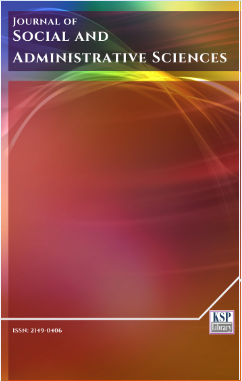The Decision Makers' Perception Toward The Adoption of Information Technology By Government Institutions In jordan and Its Affect on InformationAccessibility, and Decision Making Quality
Abstract
In this age of rapidly advancing technology, many governments around the world have spent a great deal of money on these tools, in order to increase the performance of their work. Therefore, the Jordanian government decided to implement information technology in public institutions. However, the picture is not clear about the perceptions of users towards this technology. The purpose of this study was to explore the perceptions of decision-makers towards the use of this technology and its impact on access to information and the quality of decision-making. Quantitative methodology was used to obtain the information necessary to achieve the objectives of this study. Three hundred questionnaires to decision-makers located in the city of Irbid were distributed. Two hundred sixty eight questionnaires were returned; 253 were usable, at 84% response rate. Descriptive statistics was used to analyze the data. The results indicated the importance of computer technology in the Jordanian governmental organizations. The results revealed that the majority of the participants expressed positive perceptions about the technology. They saw this technology as a viable, necessary and effective tool. However, they still expected to have more active role of this technology in government institutions. Also, they provided many of the factors that led to some restrictions on the use of computers. In addition, the study revealed that the demographic characteristics that would hinder perceptions towards this technology seems mostly unfounded. Based on the results of this study, Joradanian government should provide its employees more training and education opportunities on the use of this technology, in order to maintain, improve and increase the use of such technology in the future.
Keywords. Information technology, Decision making, E-government, Jordanian government.
JEL. C80, D37, D78, H53, H83.References
Al-Jaghoub, S., & Westrup, C. (2003). Jordan and ICT-led development: towards competition state? Information Technology & People, 16(1), 93-110. doi: 10.1108/09593840310463032
Amoretti, F. (2007). International organizations ICTs Policies: E-Democracy and E-Government for political development. Review of Policy Research, 24(4), 331-344. doi: 10.1111/j.1541-1338.2007.00286.x
Bertucci, G., & Szeremeta, J. (2006). A mature agenda for e-government development. Comparative Technology Transfer and Society, 3(3), 211-229. doi: 10.1353/ctt.2006.0002
Bloomfield, B. P., Coombs, R., Knights, D., & Littler, D. (Eds.). (2000). Information technology and organizations: Strategies, networks, and integration. Oxford: Oxford University Press.
Danziger, J. N., & Andersen, K. V. (2002). The impacts of information technology on public administration: An analysis of empirical research from the "golden age" of transformation. International Journal of Public Administration, 25(5), 591-627. doi: 10.1081/PAD-120003292
Davison, R. D., Vogel, B. H., & Jones, N. (2000). Technology leapfrogging in developing countries: An inevitable luxury?. The Electronic Journal on Information System in Developing Countries 1(5), 1-10.
Ein-Dor, P., Goodman, S., & Wolcott, P. (1999). The global diffusion of the internet project. The Hashemite Kingdom of Jordan. Retrieved on 02/03/2015 from: http://mosaic.unomaha.edu/Jordan_1999.pdf.
Hanson, J., & Narula, U. (1990). New communication technologies in developing countries. Hillsdale, NJ: Lawrence Erlbaum Associates.
Heintze, T., & Bretschneider, S. (2000). Information technology and restructuring in public organizations: Does adoption of information technology affect organizational structures, communications, and decision making? Journal of Public Administration Research and Theory, 10(4), 801-830.
Kraemer, K. L., & Dedrick, J. (1997). Computing and public organizations. Journal of Public Administration Research and Theory, 7(1), 89-112.
Kroeber, N. W., & Watson, H. J. (1987). Computer-based information systems: A management approach. New York: Macmillan Publishing.
Krumwiede, K. R., & Roth, H. P. (1997). Implementing information technology innovations: The activity-based costing example. SAM Advanced Management Journal, 62(4), 4-21.
Kulchitsky, D. R. (2004). Computerization, knowledge, and information technology initiatives in Jordan. Administration & Society, 36(1), 3-37. doi: 10.1177/0095399703257263
Mansell, R. & Wehn, U. (Eds.). (1998). Knowledge societies: Information technology for sustainable development. Oxford: Oxford University Press.
Rawabdeh, A. A. A. (2007). An e-health trend plan for the Jordanian health care system: A review. International Journal of Health Care Quality Assurance, 20(6), 516-531.
Rogers, E. M. (2003). Diffusion of innovations (5th ed.). New York: Free Press
Rohrmann, B., & Schutz, H. (1993). The evaluation of decision aids. In S. S. Nagel (Ed.), Computer-aided decision Analysis: Theory and applications. Westport, CT: Quorum Books.
Rosenbloom, D. H., & Goldman, D. D. (1998). Public administration: Understanding management, politics, and law in the public sector (4th ed.). New York: McGraw-Hill.
Simon, H. A. (1977). What computers mean for man and society. Science, New Series, 195(4283), 1186-1191.
Simon, H. A. (1990). Information technologies and organizations. The Accounting Review, 65(3), 658-667.
Stanton, D. (September 15, 2006). IT by Royal Appointment, arabianbusiness.com. Retrieved on 02/20/2015 from: http://www.arabianbusiness.com/713
United Nations Development Program (UNDP). Building the Capacity of the Government in Implementing the Service Delivery Improvement System. Retrieved on 12/25/2007 from: http://www.undp-jordan.org/
United States Agency International Development (USAID). Strategic Statement-Jordan (2007-2011), Public Version. Retrieved on 01/09/2015 from:http://jordan.usaid.gov/.
Woodrow, J. E. (1992). The influence of programming training on the computer literacy and attitudes of pre-service teachers. Journal of Research on Computing in Education, 25(2), 200-218.
DOI: http://dx.doi.org/10.1453/jsas.v2i2.290
Refbacks
- There are currently no refbacks.
....................................................................................................................................................................................................................................................................................................................................... Journal of Social and Administrative Sciences - J. Adm. Soc. Sci. - JSAS - www.kspjournals.org
ISSN: 2149-0406
Editor: editor-jsas@kspjournals.org Secretarial: secretarial@kspjournals.org Istanbul - Turkey.
Copyright © KSP Library




